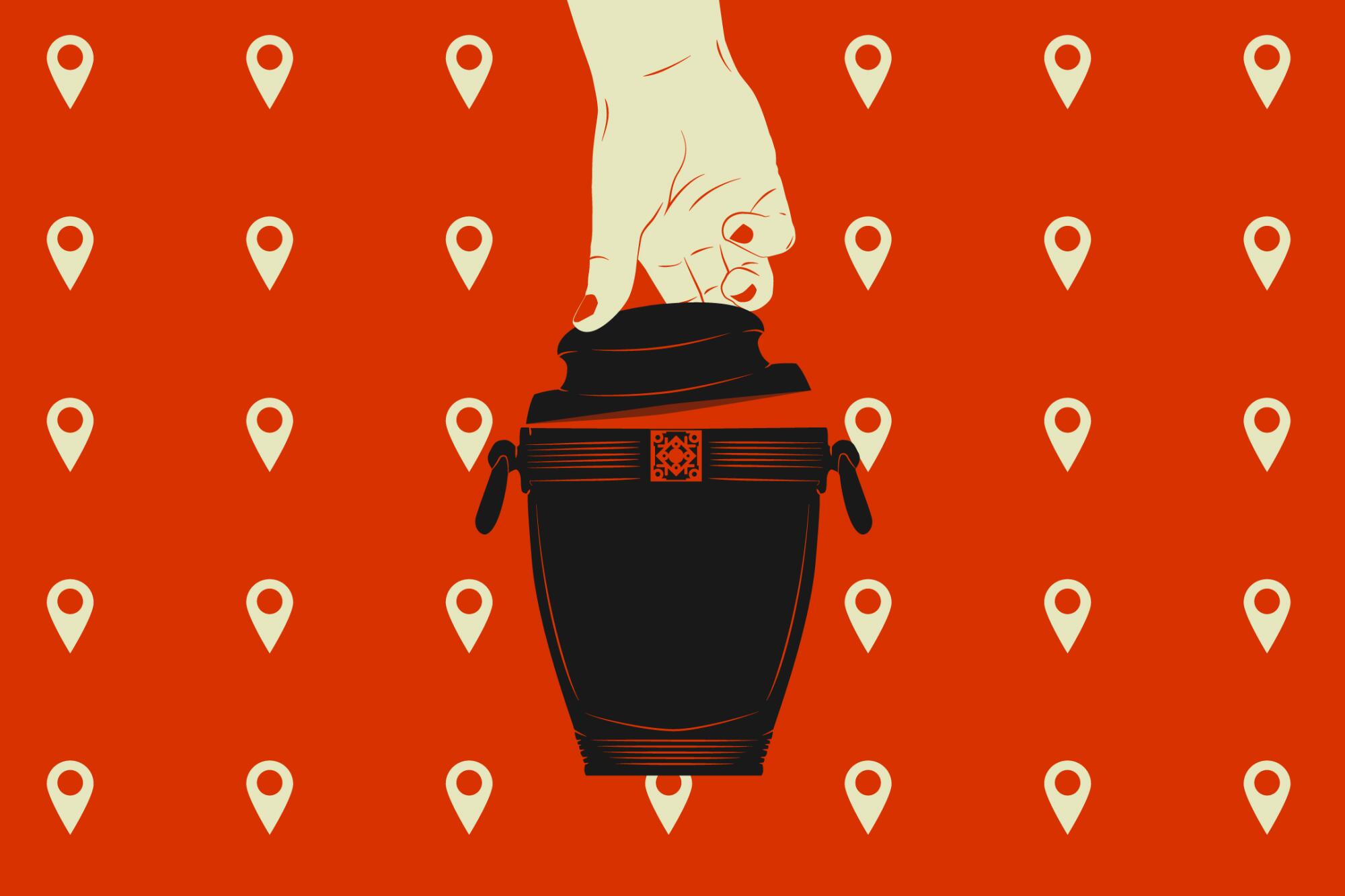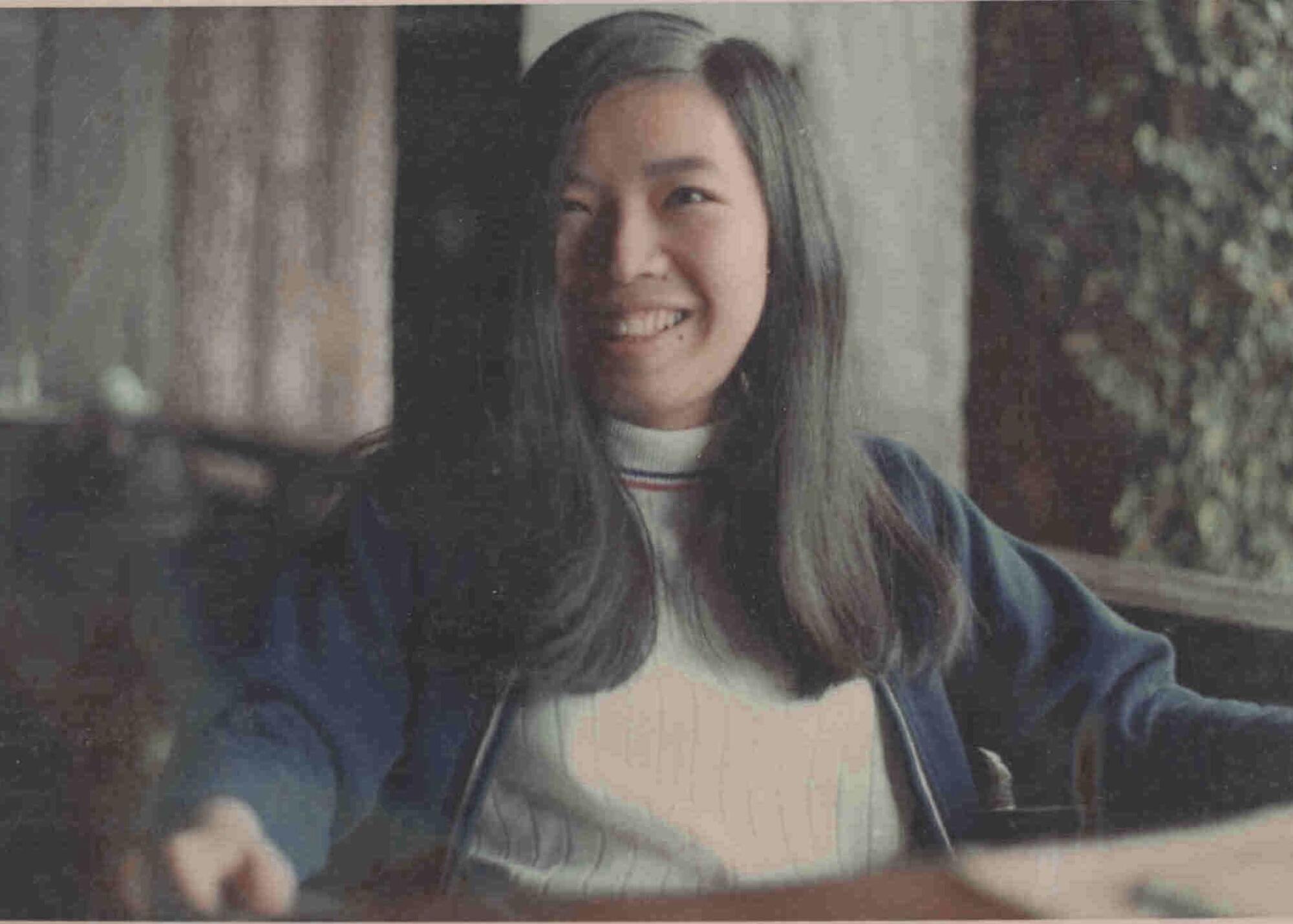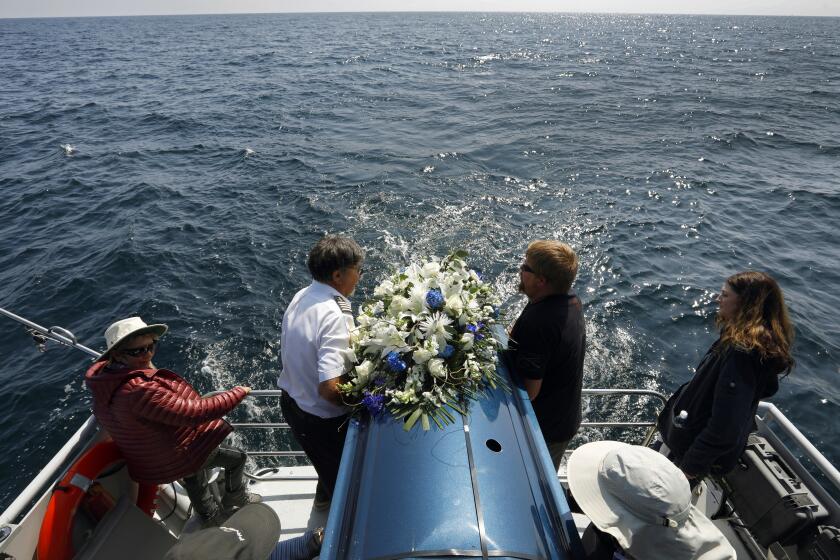
- Share via
Journalism is a death-adjacent industry. Journalists write obituaries and about murders, homicides, deaths of despair, COVID-19 death counts. Usually, we’re the ones asking questions. But working as a journalist gives you a patina of authority on some subjects, whether you’ve earned it or not. Death is one of them. You get used to getting questions from people who don’t know who else to ask.
A few months ago, I got direct message on Instagram from my oldest friend.
“Ok so. Here’s an uncomfortable question,” Sam Crews wrote. “If you were going to — hypothetically — scatter your mother’s ashes in Los Angeles, and you wanted it to be somewhere nice but you are also riddled with anxiety and fear the police; where would you go?”
I knew his dad, longtime journalist Steve Crews, had died in 2016, and that his mom Evelyn Crews had died just a month after the pandemic turned the world upside down, though not of COVID. Like many people in the 21st century, I’d learned about his parents’ deaths and sent my condolences over social media. I’d sent him a digital copy of my favorite book about grief after his mom passed.
And I thought his question was a good one. So I decided to look into it for him — professionally.
The topic of scattering cremated remains is addressed by state law in a way that raises more questions than it answers.
According to California Health and Safety Code, it is legal to scatter cremated human remains as long as you meet the following conditions:
- The place you intend to scatter them has no prohibitions on doing so.
- You have written permission from the owner or governing body of the property.
- The remains are removed from their container and not distinguishable to the public (i.e., you have sufficiently spread them so that no one can tell what they are).
How do you know if the place you intend to scatter ashes has prohibitions on doing so? How do you get written permission? Who is the governing body of a neighborhood park? A beach? A forest?
I thought these questions would be relatively easy to answer. Instead, I learned that the people who are possibly most uncomfortable talking about death seem to be the public officials who are supposed to have the answers to these questions.
I also learned that, yes, there are places in the county of L.A. where it’s legal to scatter ashes. But Los Angeles has created a bureaucracy around it so impenetrable that it all but ensures no one will follow the laws. But it seems like there are no consequences for that, because I couldn’t find any evidence that those laws are being enforced.
That’s the very, very short version of what I learned. Here’s the long version.
Talking about burial arrangements or end-of-life care isn’t the easiest conversation to have with family members. But it can be done with respect, humility and love.
What happens to our bodies when we’re done with them?
Statistically, we cremate them.
Cremation is increasingly popular in America, though it’s certainly not the only alternative to being buried. That’s a relatively new phenomenon in the history of death in America, said Tanya Marsh, a professor of law at Wake Forest School of Law whose work focuses on laws and regulations related to human remains.
According to statistics from the Cremation Assn. of North America, 57.5% of deaths in America resulted in cremation in 2021. In 2006, that number was 33.8%.
“We think it’ll probably top out around 70%,” Marsh said of the cremation rate.
What do you do when someone dies?
Because we find death so hard to talk about, there are probably lots of things people wonder but don’t know. We have answers.
There are a few reasons it has become the de facto choice. For starters, it can be quite a bit less expensive than being buried: A traditional funeral with a viewing and burial cost an average of $7,848 in 2021, according to the National Funeral Directors Assn. survey; a similar funeral with viewing but cremating instead of burying was on average $6,970. But if you opt for direct cremation — having the body cremated without a viewing or service in a funeral home or church — the average price in California is $1,610, according to end-of-life price comparison website Funeralocity.
As fewer and fewer Americans belong to a house of worship or have an active faith practice, religious objections to cremation are less of a consideration. And some people just feel weird about the idea of their corpse in a box in the ground.
“There are a lot of people who don’t want to be buried,” said Noelle Berman, the director of private estates at Hollywood Forever Cemetery in Los Angeles. “They don’t want to be in containers. They want to be free and they want to return to the earth and seed the earth and not cause any damage.”
When someone dies in California, the legal next of kin has to state what they are going to do with the remains. Funeral home workers will handle filing for a death certificate and a permit for the disposition of human remains (sometimes shortened to “burial permit,” though you get it no matter what you’re planning to do with the body). If you are having the deceased cremated, you don’t have to decide immediately whether or where you’ll scatter the ashes — you can put down your address under “place of final disposition.”
It gives people a lot of time to decide where and how to lay their loved one to rest. That can be both a good and bad thing, Marsh said.
When you’re burying a body, you have a deadline. Even an embalmed body needs to get into the ground relatively quickly. For mourners, “there’s a rhythm to that process,” Marsh said. But with cremated remains, there’s no need to decide right away what to do with them. That can lead to decision paralysis.
“I know a lot of people who have cremated remains in their closet or on their mantle. They’re waiting. Everybody’s reasons for that are personal and different. But I think the commonality is ‘I want to make the right decision.’ So I’m going to delay the decision until I figure out what the right decision is,” Marsh said.
I asked Sam what his parents had wanted. Sam said his dad had chosen to be cremated, and named a specific spot where he wanted his remains scattered. When it came to his mom’s wishes, “We knew that she wanted to be cremated and she was very specific about that,” Sam told me. “In terms of where she wanted to go afterwards, we didn’t really know.”
His thoughts turned to California.
Evelyn moved from the Philippines to Los Angeles in 1967, when she was 17. She attended Mount St. Mary’s College, then transferred to UCLA, where she got her bachelor of fine arts. L.A., he said, was where “she got to be her truest self.”

“She loved it there. What a great time to be in L.A.,” Sam said. “It was always her favorite place in the States, even more than Chicago, where she lived for 40 years. … Growing up we would go to L.A. all the time, some of her truest friends were out there, and she was always nostalgic about it. So just thinking about her, to scatter her ashes, I couldn’t think of another place she would rather be.”
The place his dad had requested was close to where we all grew up. It was a quiet place Sam knew well. L.A., less so.
“And thus started my stress,” he said. “Because I am a person who follows rules, and who fears capital-T capital-M The Man.”
He wanted to honor his mom’s life. He also didn’t want to go to jail: “I was reaching out to all the Angelenos that I know if they had any advice about places where I wouldn’t get arrested.”
People are choosing eco-friendly and creative options for their final resting places, including the bottom of the ocean and miles and miles into outer space.
If you’ve got money, you’ve got options
Sam certainly isn’t the first person to wonder where one can legally scatter ashes in L.A. So I started Googling. All of the results were search-engine-optimized pages trying to sell me something — funeral homes and crematoriums; companies that will scatter the ashes for you. I imagined there had to be places to do this that didn’t cost a fortune. Probably some environmental restrictions and municipal considerations, sure. I imagined the city didn’t want people raining human remains onto the Hollywood sign or something. Then again, what if someone caught you doing it where you weren’t supposed to? Would they arrest you? Fine you? Can a public park security guard make you un-scatter ashes?
I learned that it’s legal to toss cremated remains overboard into the ocean — like Jennifer Coolidge’s character Tanya attempted midway through Season 1 of “The White Lotus” — as long as you are at least three nautical miles from shore.

It is not legal to scatter them on the beach or coastline along the water, like Tanya eventually did in the Season 1 finale.
I did learn that you need to notify the EPA of a burial at sea within 30 days of doing so, which you can conveniently do online through the EPA’s Burial at Sea Reporting System. If you use a specific charter service, that’s one of the steps they would handle for you.
You can also scatter ashes in an inland navigable water source in California, as long as you are at least 500 yards from the shoreline. In California, a navigable water source is a body of water that is “capable of being navigated by oar or motor-propelled small craft,” so anywhere you could get into a boat and go 500 yards. State law specifies that spreading ashes from a bridge or pier does not meet that requirement.
Many charter boat companies offer this service, starting around $600.
Southern California boat captains say they have never been busier burying people at sea.
It is legal to have someone drop ashes from an airplane, starting around $500.
It is legal to scatter ashes on private property, like in your backyard. But not everyone in L.A. has a backyard. You could scatter them in someone else’s backyard, if you had their permission.
It is, of course, legal to purchase a niche in a mausoleum or cemetery.
At Hollywood Forever, and just about every other cemetery, you can inter a box or urn of ashes in the ground under a gravestone, where you’d lay the casket in a traditional burial. Some cemeteries now offer what’s known as a scattering garden, where your loved one’s remains are removed from the container and put directly into the earth. At Hollywood Forever Cemetery in Los Angeles, scattering in the rose garden is slightly less expensive than other options, and your loved one’s name goes on a plaque adjacent to their final resting place. Unlike interring the ashes, you can’t later decide to retrieve or move the ashes — they commingle with the soil. Hollywood Forever also lets you choose to conjoin ashes with the roots of a tree, to be planted in their Ancestral Forest Project.
As true in death as it is in life: People with hundreds or thousands of dollars to spare have a lot of options. But what about people who can’t afford, or don’t want, to cough up the equivalent of first and last months’ rent on a final resting place?
This is where I started getting pushback.
When someone you care for dies unexpectedly, many responsibilities will fall onto your shoulders. Here’s a guide to what they are and how to handle them.
If you don’t want to spend money, you get a bureaucratic headache
When you go with a paid service to help you scatter the ashes, they handle the paperwork for you. You might decide that’s worth it. Because if my attempt to report out how this process would work for someone doing this on their own is any indication, I wish you luck. The information I present to you here is the outcome of dozens of emails and phone calls to public officials, none of whom were particularly interested in answering my questions. Some agencies (looking at you, L.A. County Department of Beaches and Harbors) simply never responded.
So if you want to do it yourself, the proper, legal version of the process starts with a visit — in person — to the Los Angeles County Vital Records Office in downtown Los Angeles to pay $12 to obtain a new burial/transit permit.
If you visited that department’s website, it used to tell you to visit the office in Lancaster. That wasn’t correct. Aletheia Young, a representative for the Vital Records Office, couldn’t tell me why the wrong address was listed, or when that might be updated. We spoke in February. When this article published in May, the information on the website was still incorrect. In June, the website was updated and now displays the correct information.
She told me that everyone, including people who live out of state, has to go to the office in person. You need to present the death certificate as well as a transit permit obtained from the state from which you brought the remains. She couldn’t tell me how many of those permits the county processes a year.
I tried contacting a very helpful person I know at the county Department of Public Health, who said she would try to look into it for me. She was able to extract this statement from Vital Records, which she emailed to me: “We do not track the number of permits issued each year. A burial permit is issued when a death is registered. If cremated remains are divided for placement at more than one location, a permit is issued for each location. Subsequent permits are issued for various reason (sic). Approximately 70,000 deaths are registered each year. We do not have any information regarding citations.” Over months of asking, no one responded with specifics to my questions about enforcement of the health code.
What about scattering ashes at sea? Will any boat do? Or do you have to charter a specific boat service? If a friend had a boat, could they take you three nautical miles out and you could do it that way?
Beaches and Harbors simply wouldn’t return my calls. The city and county parks departments told me they didn’t know.
I found my answer when I dug into the three-mile requirement. The first three nautical miles from shore are under the state’s jurisdiction. Farther than that, and you are in U.S. territorial waters, where the EPA has jurisdiction. So you can theoretically charter any boat, including a friend’s boat, and as long as you get three nautical miles from shore and file with the EPA within 30 days, you are in compliance.
Next, I wanted to know whether any government-owned locations in L.A. met the “no prohibitions on doing so” aspect of the law. After many more phone calls, I learned it is legal to scatter ashes in some state and county parks, though not a Los Angeles city park. (Off the top of your head, can you tell me which parks in L.A. are state or county parks versus city parks? Me neither.)

Many of these places have beautiful and discreet hiking trails. You have to be at least 75 feet from the trail and disperse the remains thoroughly enough that they are not distinguishable as human ashes.
I thought: This is exactly what I was looking for. An inexpensive, eco-friendly way to scatter ashes. Easy.
Before you can scatter ashes in a state park, the county parks information officer told me, you have to complete an application to scatter human remains and pay $25. To get the application, you can call the Angeles Parks District at (818) 880-0363 and they will send you a copy and let you know to whom you send the completed forms. You can also download and fill out a form (linked in the module below) and then call and ask what email address you have to send it to.
The permit for scattering human remains in a state park in the Angeles district of California.
The person I spoke to at the parks department gave me the email address for the person you currently have to go through to get the permit approved, an environmental scientist named Noa Rishe Khalili. She did not respond to my emails or calls — not even when I dug up her cellphone number on an unrelated public document on the city of Malibu website — until I emailed the main parks department address again and said I was having trouble getting in touch. Finally, she called me back. I honestly can’t fathom how a grieving person is expected to navigate this part of the process.
She walked me through the process — mainly, she makes sure the place you plan to scatter your loved one’s remains isn’t ecologically or culturally protected. She said it could take up to two months to get a signoff. I asked her how many of these permits she gets per year.
“Not that many. We get 10, maybe 15,” she said. Then, with a not-imperceptible tinge of bitterness: “Probably more now you’re writing this.”
So, in sum: Yes, there are ways to scatter your loved one’s ashes for close to free. It’s just a huge headache to undertake on your own.
I asked Sam what the chances were, percentage-wise, of him flying to L.A. and visiting the downtown (not Lancaster!) Vital Records office with a death certificate and a transit permit from the state of Illinois, and then applying for a parks permit with a two-month turnaround time.
“Zero.”
About half the U.S. population, including 18 million Californians, are registered organ donors. But whether you can actually donate organs depends on how you die, among other limiting factors.
It doesn’t have to be like this. In most places, it isn’t
Still, Sam doesn’t want to break any rules. But faced with the legal roadblocks the state, city and county governments have put up, coupled with the apparent lack of enforcement, who would willingly engage with this process?
“California has some of the most bureaucratic rules with respect to the disposition of cremated remains,” said Marsh, the law professor. She said that in every other state, the prevailing view is that cremation constitutes the final disposition of the remains, as far as the government is concerned. In other words, they don’t really care what you do with the ashes.
“The exception in the United States is California,” she said. “In California, you have to tell the state where the cremated remains are going.”
But why?
“Honestly, I have no idea why. I can’t imagine they do anything with that information.”
A side effect of this level of bureaucracy, she said, is that it creates a professional class that navigates the complicated system for you. The people who will sail you out three nautical miles, or drop your loved one’s remains out of a plane while you watch from the shore. Those services exist in other states but aren’t as necessary as they are in California.
“What happens when you put these kinds of overly burdensome restrictions on people without any clear connection to why, then it just encourages people to ignore the rules completely,” Marsh said.
At the end of our conversation, Sam told me he still wasn’t exactly sure where he’d scatter his mom. He said he found himself looking up places where people could do other illegal things, figuring that if you could fire a gun somewhere, you could also probably lay your mom to rest without being disturbed.
He said he wished it was easier to do this legally.
“I love paying money for the right to do things,” he said. “If there was a bright shiny website where they said, ‘Leave your mother in LA!,’” I would go on that website, and I would pay them far more than $12 for the right to do it.”
About The Times Utility Journalism Team
This article is from The Times’ Utility Journalism Team. Our mission is to be essential to the lives of Southern Californians by publishing information that solves problems, answers questions and helps with decision making. We serve audiences in and around Los Angeles — including current Times subscribers and diverse communities that haven’t historically had their needs met by our coverage.
How can we be useful to you and your community? Email utility (at) latimes.com or one of our journalists: Jon Healey, Ada Tseng, Jessica Roy and Karen Garcia.
More to Read
Updates
4:42 p.m. June 13, 2023: June 13, 2023: The website for the Vital Records Office has been updated and now shows the correct information for obtaining a burial permit.
Sign up for The Wild
We’ll help you find the best places to hike, bike and run, as well as the perfect silent spots for meditation and yoga.
You may occasionally receive promotional content from the Los Angeles Times.
















